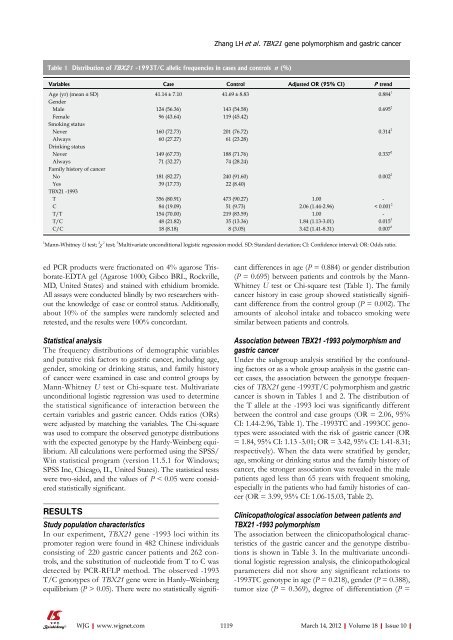10 - World Journal of Gastroenterology
10 - World Journal of Gastroenterology
10 - World Journal of Gastroenterology
You also want an ePaper? Increase the reach of your titles
YUMPU automatically turns print PDFs into web optimized ePapers that Google loves.
Table 1 Distribution <strong>of</strong> TBX21 -1993T/C allelic frequencies in cases and controls n (%)<br />
ed PCR products were fractionated on 4% agarose Trisborate-EDTA<br />
gel (Agarose <strong>10</strong>00; Gibco BRL, Rockville,<br />
MD, United States) and stained with ethidium bromide.<br />
All assays were conducted blindly by two researchers without<br />
the knowledge <strong>of</strong> case or control status. Additionally,<br />
about <strong>10</strong>% <strong>of</strong> the samples were randomly selected and<br />
retested, and the results were <strong>10</strong>0% concordant.<br />
Statistical analysis<br />
The frequency distributions <strong>of</strong> demographic variables<br />
and putative risk factors to gastric cancer, including age,<br />
gender, smoking or drinking status, and family history<br />
<strong>of</strong> cancer were examined in case and control groups by<br />
Mann-Whitney U test or Chi-square test. Multivariate<br />
unconditional logistic regression was used to determine<br />
the statistical significance <strong>of</strong> interaction between the<br />
certain variables and gastric cancer. Odds ratios (ORs)<br />
were adjusted by matching the variables. The Chi-square<br />
was used to compare the observed genotype distributions<br />
with the expected genotype by the Hardy-Weinberg equilibrium.<br />
All calculations were performed using the SPSS/<br />
Win statistical program (version 11.5.1 for Windows;<br />
SPSS Inc, Chicago, IL, United States). The statistical tests<br />
were two-sided, and the values <strong>of</strong> P < 0.05 were considered<br />
statistically significant.<br />
RESULTS<br />
Study population characteristics<br />
In our experiment, TBX21 gene -1993 loci within its<br />
promoter region were found in 482 Chinese individuals<br />
consisting <strong>of</strong> 220 gastric cancer patients and 262 controls,<br />
and the substitution <strong>of</strong> nucleotide from T to C was<br />
detected by PCR-RFLP method. The observed -1993<br />
T/C genotypes <strong>of</strong> TBX21 gene were in Hardy–Weinberg<br />
equilibrium (P > 0.05). There were no statistically signifi-<br />
WJG|www.wjgnet.com<br />
Zhang LH et al . TBX21 gene polymorphism and gastric cancer<br />
Variables Case Control Adjusted OR (95% CI) P trend<br />
Age (yr) (mean ± SD) 41.14 ± 7.<strong>10</strong> 41.69 ± 8.83 0.884 1<br />
Gender<br />
Male 124 (56.36) 143 (54.58) 0.695 2<br />
Female 96 (43.64) 119 (45.42)<br />
Smoking status<br />
Never 160 (72.73) 201 (76.72) 0.314 2<br />
Always 60 (27.27) 61 (23.28)<br />
Drinking status<br />
Never 149 (67.73) 188 (71.76) 0.337 2<br />
Always 71 (32.27) 74 (28.24)<br />
Family history <strong>of</strong> cancer<br />
No 181 (82.27) 240 (91.60) 0.002 2<br />
Yes 39 (17.73) 22 (8.40)<br />
TBX21 -1993<br />
T 356 (80.91) 473 (90.27) 1.00 -<br />
C 84 (19.09) 51 (9.73) 2.06 (1.44-2.96) < 0.001 2<br />
T/T 154 (70.00) 219 (83.59) 1.00 -<br />
T/C 48 (21.82) 35 (13.36) 1.84 (1.13-3.01) 0.015 3<br />
C/C 18 (8.18) 8 (3.05) 3.42 (1.41-8.31) 0.007 3<br />
1 Mann-Whitney U test; 2 χ 2 test; 3 Multivariate unconditional logistic regression model. SD: Standard deviation; CI: Confidence interval; OR: Odds ratio.<br />
cant differences in age (P = 0.884) or gender distribution<br />
(P = 0.695) between patients and controls by the Mann-<br />
Whitney U test or Chi-square test (Table 1). The family<br />
cancer history in case group showed statistically significant<br />
difference from the control group (P = 0.002). The<br />
amounts <strong>of</strong> alcohol intake and tobacco smoking were<br />
similar between patients and controls.<br />
Association between TBX21 -1993 polymorphism and<br />
gastric cancer<br />
Under the subgroup analysis stratified by the confounding<br />
factors or as a whole group analysis in the gastric cancer<br />
cases, the association between the genotype frequencies<br />
<strong>of</strong> TBX21 gene -1993T/C polymorphism and gastric<br />
cancer is shown in Tables 1 and 2. The distribution <strong>of</strong><br />
the T allele at the -1993 loci was significantly different<br />
between the control and case groups (OR = 2.06, 95%<br />
CI: 1.44-2.96, Table 1). The -1993TC and -1993CC genotypes<br />
were associated with the risk <strong>of</strong> gastric cancer (OR<br />
= 1.84, 95% CI: 1.13 -3.01; OR = 3.42, 95% CI: 1.41-8.31;<br />
respectively). When the data were stratified by gender,<br />
age, smoking or drinking status and the family history <strong>of</strong><br />
cancer, the stronger association was revealed in the male<br />
patients aged less than 65 years with frequent smoking,<br />
especially in the patients who had family histories <strong>of</strong> cancer<br />
(OR = 3.99, 95% CI: 1.06-15.03, Table 2).<br />
Clinicopathological association between patients and<br />
TBX21 -1993 polymorphism<br />
The association between the clinicopathological characteristics<br />
<strong>of</strong> the gastric cancer and the genotype distributions<br />
is shown in Table 3. In the multivariate unconditional<br />
logistic regression analysis, the clinicopathological<br />
parameters did not show any significant relations to<br />
-1993TC genotype in age (P = 0.218), gender (P = 0.388),<br />
tumor size (P = 0.369), degree <strong>of</strong> differentiation (P =<br />
1119 March 14, 2012|Volume 18|Issue <strong>10</strong>|

















